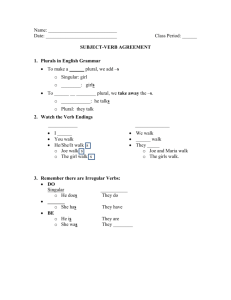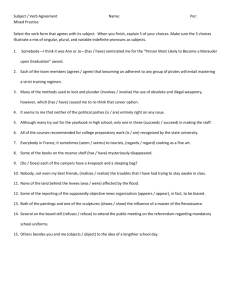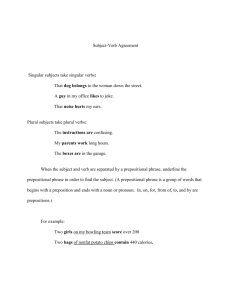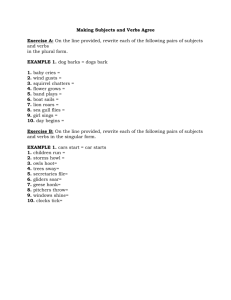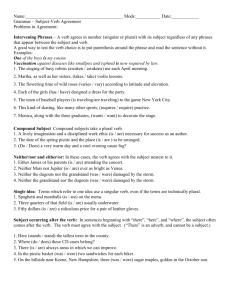Subject-Verb Agreement
advertisement
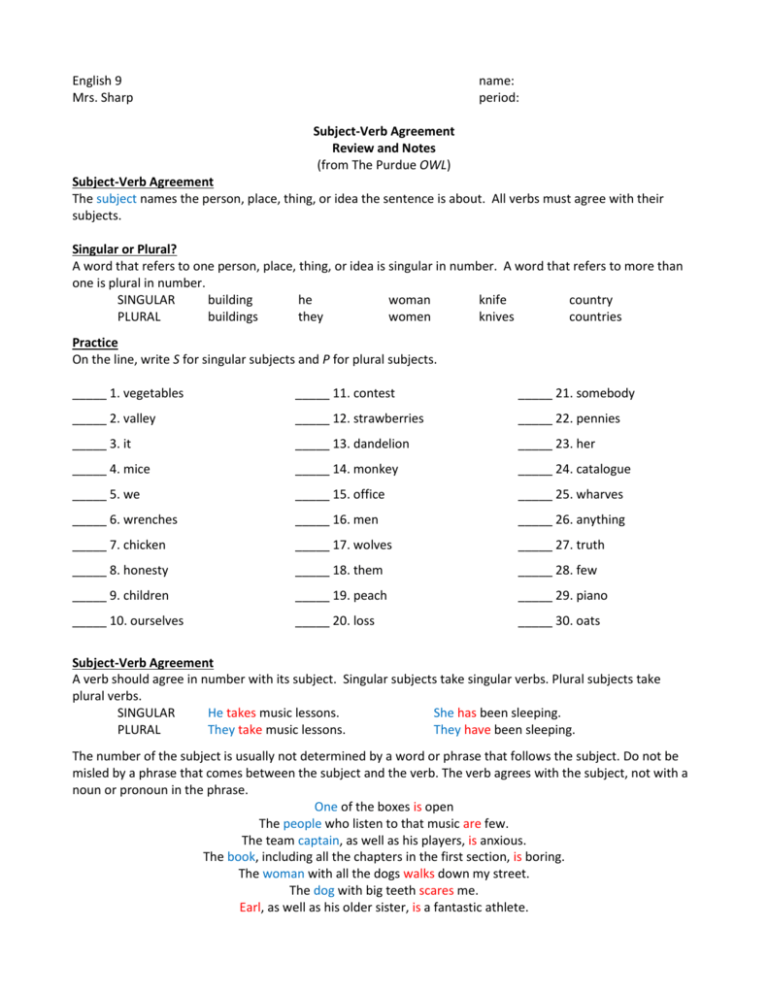
English 9 Mrs. Sharp name: period: Subject-Verb Agreement Review and Notes (from The Purdue OWL) Subject-Verb Agreement The subject names the person, place, thing, or idea the sentence is about. All verbs must agree with their subjects. Singular or Plural? A word that refers to one person, place, thing, or idea is singular in number. A word that refers to more than one is plural in number. SINGULAR building he woman knife country PLURAL buildings they women knives countries Practice On the line, write S for singular subjects and P for plural subjects. _____ 1. vegetables _____ 11. contest _____ 21. somebody _____ 2. valley _____ 12. strawberries _____ 22. pennies _____ 3. it _____ 13. dandelion _____ 23. her _____ 4. mice _____ 14. monkey _____ 24. catalogue _____ 5. we _____ 15. office _____ 25. wharves _____ 6. wrenches _____ 16. men _____ 26. anything _____ 7. chicken _____ 17. wolves _____ 27. truth _____ 8. honesty _____ 18. them _____ 28. few _____ 9. children _____ 19. peach _____ 29. piano _____ 10. ourselves _____ 20. loss _____ 30. oats Subject-Verb Agreement A verb should agree in number with its subject. Singular subjects take singular verbs. Plural subjects take plural verbs. SINGULAR He takes music lessons. She has been sleeping. PLURAL They take music lessons. They have been sleeping. The number of the subject is usually not determined by a word or phrase that follows the subject. Do not be misled by a phrase that comes between the subject and the verb. The verb agrees with the subject, not with a noun or pronoun in the phrase. One of the boxes is open The people who listen to that music are few. The team captain, as well as his players, is anxious. The book, including all the chapters in the first section, is boring. The woman with all the dogs walks down my street. The dog with big teeth scares me. Earl, as well as his older sister, is a fantastic athlete. PRACTICE Exercise A In each of the following sentences, the verb agrees with its subject. Underline and label the subject S and the verb V. Then, in the margin next to the sentence number, write S if the subject and verb are singular and P if the subject and verb are plural. 1. Gwendolyn Brooks is an award-winning African American poet. 2. For several years she has served as the poet laureate of Illinois. 3. Many poems by Brooks express anger for the injustice of racial discrimination. 4. Two volumes of her poetry are Annie Allen and A Street in Bronzeville. 5. One day I hope to be as eloquent a poet as Gwendolyn Brooks. Exercise B In the following sentences, underline and label the subject S. Then, circle the verb in the parenthesis that agrees with the subject. 1. The city of Buenos Aires (is, are) the capital of Argentina. 2. Today, almost nine million citizens (live, lives) in the city and its surrounding area. 3. The offices of Argentina’s president (is, are) housed within the city. 4. The land area of Argentina (cover, covers) over a million square miles. 5. The width of the country from east to west (is, are) only about 884 miles. 6. Some people who look at Argentina on a map (see, sees) a triangular-shaped country. Indefinite Pronouns The words each, each one, either, neither, everyone, everybody, anybody, anyone, nobody, somebody, someone, and no one are singular and require a singular verb. Each of these hot dogs is juicy. Everybody knows Mr. Jones. Either is correct. The indefinite pronouns both, few, many, and several are plural. Several of the athletes were at the banquet. The indefinite pronouns all, any, more, most, none, and some may be singular or plural, depending on their meaning in the sentence. Most of our vacation is over. (Most refers to the singular noun vacation.) Most of the days have passed. (Most refers to the plural noun days.) 2 PRACTICE Each of the following sentences has an indefinite pronoun as a subject. Write S above the pronoun if it is singular and P above it if it is plural. Then, circle the correct form of the verb in parenthesis. 1. Neither of the contestants (knows, know) the answer to the question. 2. (Has, Have) all of the ice melted? 3. Everybody in the theater (is, are) standing and cheering. 4. Many of the tickets to the play (have, has) been sold. 5. Both of the candidates for the job (seems, seem) capable. 6. No one at the party (recognizes, recognize) Stefan. 7. Each of the Maramoto brothers (has, have) applied for a scholarship. 8. Most of the musicians (respect, respects) the conductor. 9. Some of the story (was, were) difficult to understand. 10. (Is, Are) either of the doctors available for an appointment tomorrow? Compound Subjects A compound subject is a subject comprised of more than one noun or pronoun. There are usually connecting words (conjunctions) between the nouns/pronouns. Depending on the words used between the subjects, the verb may be singular or plural. 1. When the subject of a sentence is composed of two or more nouns or pronouns connected by and, use a plural verb. She and her friends are at the fair. 2. When two or more singular nouns or pronouns are connected by or or nor, use a singular verb. The book or the pen is in the drawer. 3. When a compound subject contains both a singular and a plural noun or pronoun joined by or or nor, the verb should agree with the part of the subject that is nearer the verb. The boy or his friends run every day. His friends or the boy runs every day. 3 PRACTICE Exercise A Underline the subjects in each sentence and label them S. Then, circle the verb in parenthesis that agrees with the subjects of the sentence. 1. The producer and director of Schindler’s List (was, were) Steven Spielberg. 2. Eight Crew members and a captain (was, were) hired for the cruise. 3. Neither her manuscript nor her research notes (was, were) lost in the fire. 4. Whoopi Goldberg or Billy Crystal (is, are) presenting the next award. 5. Rice and beans (is, are) her favorite meal. Exercise B In the following sentences, underline the subjects and label them S. Then, cross out and correct any verb that doesn’t agree with its subject. If the verb does agree with the subjects, write C in the margin next to the sentence number. 1. Thrilling rides and a tall roller coaster makes this amusement park more fun. 2. Either the water rides or the new roller coaster are down that path. 3. Neither Roger nor the twins want to ride the tallest roller coaster. 4. Ted and Natalie is going to the food court. 5. Two drinks or a sandwich cost about the same. Don’t and Doesn’t Doesn't is a contraction of does not and should be used only with a singular subject. Don't is a contraction of do not and should be used only with a plural subject. The exception to this rule appears in the case of the first person and second person pronouns I and you. With these pronouns, the contraction don't should be used. He doesn't like it. They don't like it. PRACTICE In each of the sentences below, the contractions don’t and doesn’t appear in parenthesis. Underline the subject(s) of each sentence and label them S. Then, circle the correct form of the verb that agrees with the subject. 1. A desert (don’t, doesn’t) get much rain. 2. (Don’t, Doesn’t) these kinds of fruit contain a lot of vitamin C? 3. Some of the spectators watching the magician (don’t, doesn’t) realize he is creating illusions. 4. The jazz band at Maria’s school (don’t, doesn’t) perform every month. 5. One of the girls (don’t, doesn’t) intend to go to the football game. 6. You and she (don’t, doesn’t) have to coordinate your plans. 7. The leaves on the pecan tree typically (don’t, doesn’t) start falling off until mid-October. 8. It really (don’t, doesn’t) matter to me whether we leave now or in fifteen minutes. 4 Collective Nouns Collective nouns are words that imply more than one person but that are considered singular and take a singular verb, such as group, team, committee, class, and family. The team runs during practice. The committee decides how to proceed. The family has a long history. My family has never been able to agree. The crew is preparing to dock the ship. (This sentence is referring to the individual efforts of each crew member.) PRACTICE In the following sentences, underline the collective noun subject and label it S. Then, circle the verb in parenthesis that agrees with the collective noun. 1. A troop of Boy Scouts (is, are) a welcome sight to a lost hiker. 2. During the past month, the army (has, have) run commercials on television. 3. The choir (meet, meets) for practice at seven o’clock. 4. The class (was, were) introduced to the state representative. 5. The public (voice, voices) its opinion by casting votes in elections. 6. The club (welcome, welcomes) Ms. Perez, the guest speaker. 7. A flock of geese (is, are) flying overhead. 8. A large number (has, have) received rebates by mail. OTHER SPECIAL CASES Nouns such as civics, mathematics, dollars, measles, and news require singular verbs. The news is on at six. Note: the word dollars is a special case. When talking about an amount of money, it requires a singular verb, but when referring to the dollars themselves, a plural verb is required. Five dollars is a lot of money. Dollars are often used instead of rubles in Russia. An expression of amount (a measurement, a percentage, a fraction, etc.) may be singular or plural, depending on how it is used in the sentence. Ten dollars was the price. Ten dollars were scattered on the ground. Fifteen percent of the check is a fair tip. Fifteen percent of the members are in agreement. 5 PRACTICE In the following sentences, underline the subjects and label them S. Then, cross out and correct any verb that doesn’t agree with its subject. If the verb does agree with the subject, write C in the margin next to the sentence number. 1. Three quarters of the flour have been added to the cake batter. 2. Around four years are needed to earn a typical college degree. 3. Five miles is the distance between your ranch and the nearest town. 4. Two pints fill a one-quart jar. 5. Three quarters of the fruit salad have been eaten already. 6. Three hours are enough time for test preparation. 7. Six candles is neatly arranged on the table. 8. Sixteen ounces equal one pound. Even when plural, the title of a creative work (book, movie, song, or painting) generally takes a singular verb. Star Wars was directed by George Lucas. Even when in plural form, the name of a country, city, or an organization generally takes a singular verb. Computer Works is on Main Street. PRACTICE In the following sentences, underline the subjects and label them S. Then, cross out and correct any verb that doesn’t agree with its subject. If the verb does agree with the subject, write C in the margin next to the sentence number. 1. Lord of the Flies were my favorite book last year. 2. New Braunfels are a town on the Guadalupe River in Texas. 3. Molasses are delicious in homemade cookies and gingerbread. 4. Buffalos in Combat was painted in India in the late sixteenth century. 5. Mathematics challenge me to think creatively about solving problems. 6. The United States is part of North America. 7. Copies and More are advertising in the student newspaper. 8. “The Hills,” by George Oppen, are written in first and second person. 6 Nouns such as scissors, tweezers, trousers, and shears require plural verbs. (There are two parts to these things.) These scissors are dull. Those pants are made of wool. A subject preceded by every or many a(n) takes a singular verb. Every student and teacher was applauding. Many a cheer was heard. PRACTICE In the following sentences, underline the subject and label it S. Then, circle the verb in parenthesis that agrees with the subject. 1. Many a young person (enjoy, enjoys) the charming performance of mimes. 2. Every act and skit of the mime (center, centers) on gesture, movement, and expression. 3. Many a child and parent (has, have) seen Emmett Kelly or a clown like him. 4. Emmett Kelly’s trousers (was, were) always brown. 5. Every student and practitioner of mime (is, are) sure to have heard of Marcel Marceau. 6. Every fan and film student (know, knows) his much-loved character, Bip. 7. Scissors (is, are) used to create collages of pictures of mimes. 7


